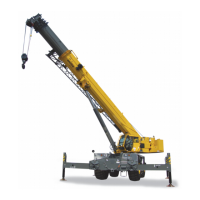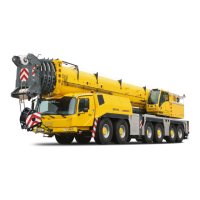BOOM RT9130E-2 SERVICE MANUAL
4-16 Published 11-22-2016, Control # 345-12
1. Install the spacers and sheaves onto the sheave shaft
while installing the sheave shafts into the boom nose.
NOTE: The lockwasher can be used more than once but
must be replaced if not in good condition.
NOTE: Install the lockwasher onto the sheave shaft with
the tabs facing out.
2. Install the locknut, washer, keyed washer, and shims (if
necessary) onto the boom nose sheave shaft with the
chamfer side out. Install the collar onto the opposite end
of the sheave shafts and secure in place with the bolt,
washer, and nut.
NOTE: If more than one shim is required, install an equal
amount on each side of the boom nose.
3. Tighten the locknut until the play in the entire assembly
is within 0.03 to 0.06 in (1 to 2 mm) total. Install shims as
necessary to achieve the correct dimension. Bend the
lockwasher tabs to secure the locknut in place.
4. Install the cable retainer pins into the upper and lower
part of the boom nose and secure in place with the hitch
pins.
Additional Maintenance, Disassembled
Boom
1. Clean all boom sections and inspect for wear, dents,
bent or crooked boom sections, gouged metal, broken
welds or any abnormal conditions. Repair or replace as
required.
2. Inspect all sheaves for excessive groove wear or
abnormal rim wear. Replace as required.
3. Inspect all sheave bearings for excessive wear or cut
inner liner material. If installed bearing diameter is 0.015
in larger than pin diameter, bearing must be replaced.
Any cut or gouge which causes the bearing liner to lose
strands is cause for bearing replacement.
4. Clean and inspect all extend and retract cable
assemblies according to wire rope inspection
procedures in this section. Pay particular attention to
any wire breakage at the end connections. Replace
cable assemblies as required. Lubricate all cable
assemblies as required. Lubricate all cable assemblies
before reinstalling them in boom.
5. Inspect all sheave pins for nicks, gouges or pitting due to
rust in the bearing surface area. Replace if any damage
is evident.
6. Inspect all grease fittings and grease paths in pins to
ensure proper grease flow. Clean and replace as
required.
7. Inspect all wear pads for excessive wear, gouges, or
abnormal conditions. Clean and replace as required.
Boom Assembly
NOTE: Apply Loctite 243 to the threads of all attaching
hardware except cable ends and cable lock nuts.
Apply multipurpose grease (MPG) to all wear
surfaces.
Use standard Grade 5 and/or 8 torque values
specified in Fasteners and Torque Values, page 1-
18 in this manual, unless otherwise specified.
The boom assembly must be rotated 180° (upside
down) before performing any assembly or
disassembly procedures.
A secure fixture that will prevent damage to the
boom is recommended to stabilize and hold the
boom from moving during insertion of section or
sections.
1. Install wear pads on the bottom of the upper telescope
cylinder support foot using two screws each.
2. Install the support foot and the sheave mounting
assembly on the front of the upper telescope cylinder
assembly, with four capscrews and washers. Attach the
support foot and the sheave mounting assembly
together using two capscrews and washers.
NOTE: The sheave shaft should be installed with grease
fitting hole to the left side.
3. Using the sheave shaft, install the sheave assembly in
the sheave mounting assembly, making sure the grease
fitting hole is toward the left of the assembly.
Secure the shaft and the cable guide with a plate and
two capscrews and washers on each side of the sheave
mounting assembly. Install grease fitting in the shaft and
apply grease.
4. Route the end of the five extension cables up and
around the upper telescope cylinder sheaves about one
foot on to cylinder. To aid in assembly, secure the cables
to the end of the cylinder by wrapping tape around the
cylinder.
5. Position the cable retainer plate on the front of the
sheave mounting assembly and secure with two
capscrews and washers.
CAUTION
Possible Equipment Damage!
When adjusting cables, hold the cable end and turn the
nut. Do not allow the cable to turn. Turning of the cable
while adjusting will result in damage or failure of cable.
Install cables in their natural untwisted condition. Do not
twist cable. Twisting of cable will result in damage or
failure of cable.

